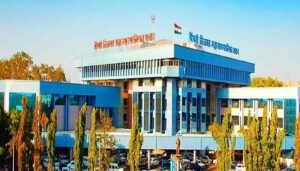Race To The Moon’s South Pole Heats Up: India’s Chandrayaan-3 And Russia’s Luna-25 Compete For Lunar Landings

New Delhi, 17th August 2023: The Indian Space Research Organisation (ISRO) has achieved a significant milestone with its Chandrayaan-3 lunar mission. The spacecraft has successfully entered a nearly circular orbit around the Moon following a precise manoeuvre executed on Wednesday. This manoeuvre effectively aligned the spacecraft into its designated lunar orbit. Notably, the upcoming step involves the planned separation of the Vikram lander from the propulsion module, which is scheduled to occur today.
The competition to explore the uncharted south pole of the Moon has gained momentum as both India’s Chandrayaan-3 and Russia’s Luna-25 are poised for lunar landings in the coming week. Beyond the captivating rivalry in the celestial realm, these missions carry profound implications. Chandrayaan-3 aspires to be the pioneer in touching down on the Moon’s south pole, while Luna-25’s rapid trajectory has garnered attention from experts, illuminating new perspectives. The proximity of their anticipated landing dates, specifically August 21-23 for Luna-25 and August 23-24 for Chandrayaan-3 has amplified global interest.
Embarking on its journey on July 14 of this year, Chandrayaan-3 marks the third instalment in India’s lunar exploration series. It triumphantly achieved lunar orbit entry on August 5, diligently fine-tuning its orbit to prepare for a delicate landing endeavour within 40 days of its launch.
Russia, making a significant return to lunar exploration after nearly five decades since the iconic Soviet-era Luna-24 mission in 1976, successfully launched Luna-25 on August 10. Its trajectory is more direct, potentially enabling an earlier landing attempt as soon as August 21, a mere 11 days after launch. This swift progress is attributed to the mission’s efficient lightweight design and streamlined fuel storage, allowing for a more expedient route to its lunar destination.
“Will the outcome of this race hold significance? While in the grand panorama of cosmic exploration, the order of arrival might not drastically reshape the lunar landscape, the insights garnered from each mission will undoubtedly enhance our comprehension of the Moon’s historical evolution and future potential. The true value lies in the cumulative achievements of our collaborative endeavours,” remarked Chrisphin Karthick, a scientist from the Indian Institute of Astrophysics in Bangalore, during a conversation with PTI.
A pivotal factor contributing to the divergent arrival times of the two missions is their respective mass and fuel efficiency. Luna-25 boasts a leaner lift-off mass of merely 1,750 kilograms, markedly lighter than Chandrayaan-3’s 3,800 kg. This reduced mass empowers Luna-25 to achieve more efficient acceleration, as highlighted by India’s space agency ISRO.







